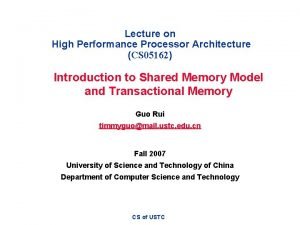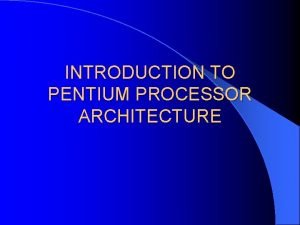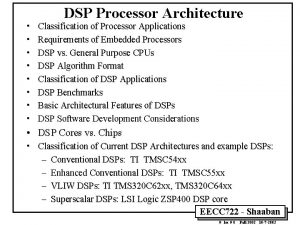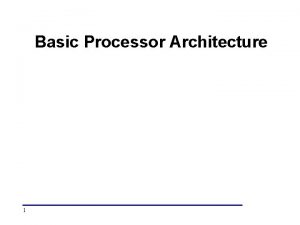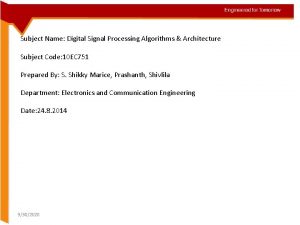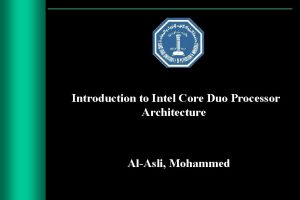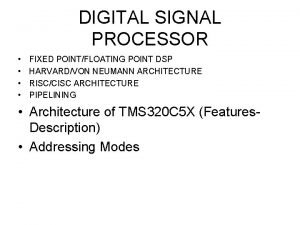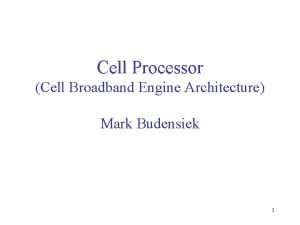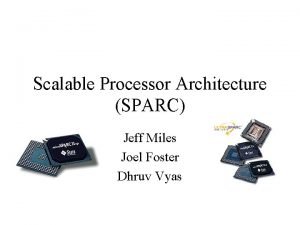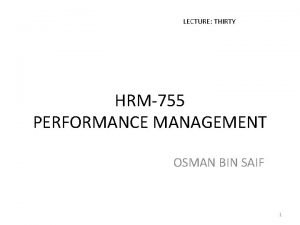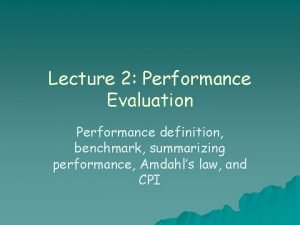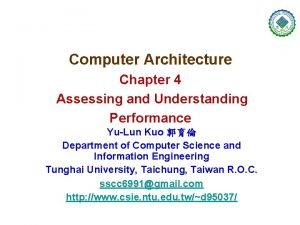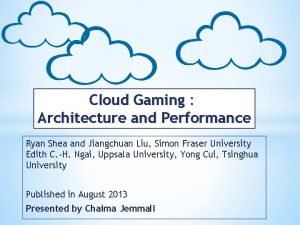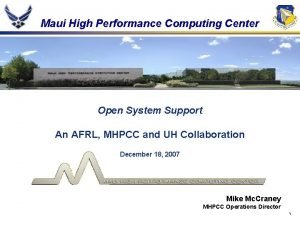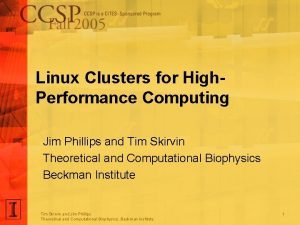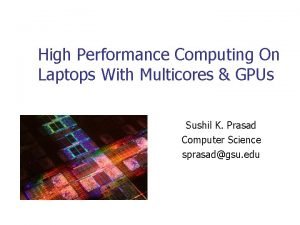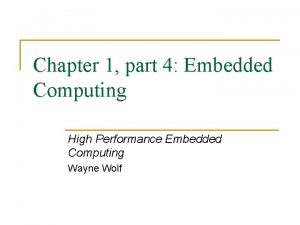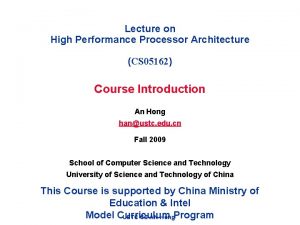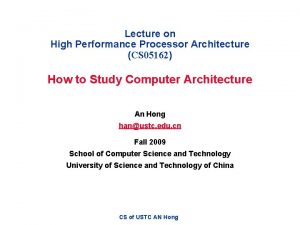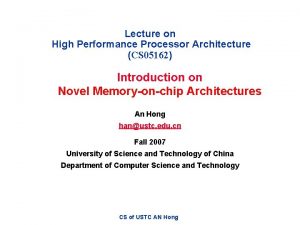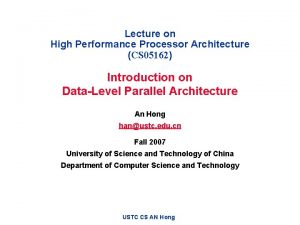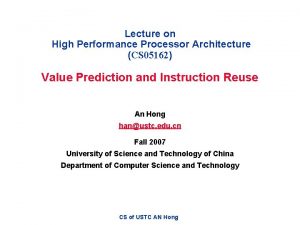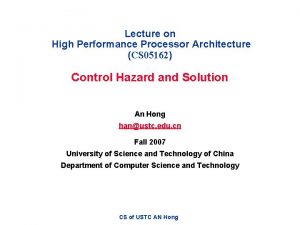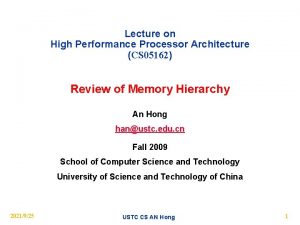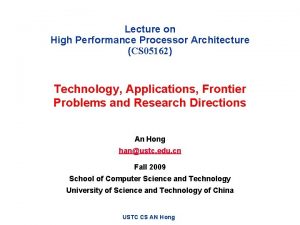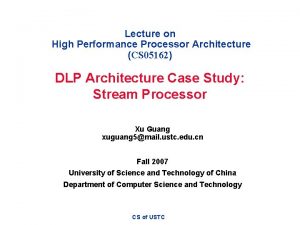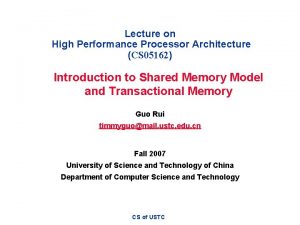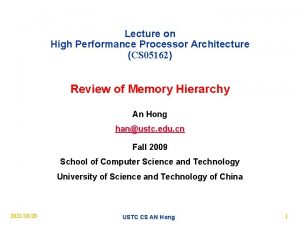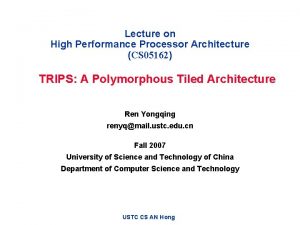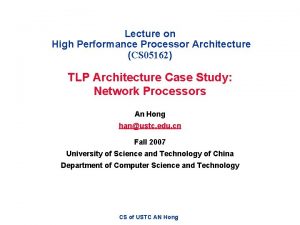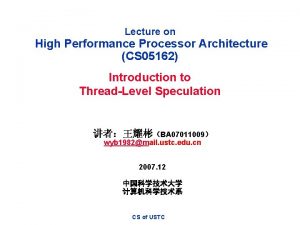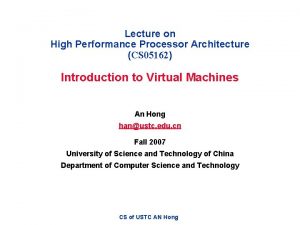Lecture on High Performance Processor Architecture CS 05162




























- Slides: 28

Lecture on High Performance Processor Architecture (CS 05162) Limits on Instruction-Level Parallelism An Hong han@ustc. edu. cn Fall 2007 University of Science and Technology of China Department of Computer Science and Technology CS of USTC AN Hong

Limits to ILP n Conflicting studies of amount − Benchmarks (vectorized Fortran FP vs. integer C programs) − Hardware sophistication − Compiler sophistication n How much ILP is available using existing mechanisms with increasing HW budgets? n Do we need to invent new HW/SW mechanisms to keep on processor performance curve? − DLPs: Intel MMX, SSE 2; Stream Processors − TLPs: IBM Power 5 (SMT/CMP) − PCAs: RAW, Smart Memory, TRIPS − etc. 2021/9/6 CS of USTC AN Hong 2

Overcoming Limits n Advances in compiler technology + significantly new and different hardware techniques may be able to overcome limitations assumed in studies n However, unlikely such advances when coupled with realistic hardware will overcome these limits in near future 2021/9/6 CS of USTC AN Hong 3

Limits to ILP n Initial HW Model here; MIPS compilers. Assumptions for ideal/perfect machine to start: 1. Register renaming − infinite virtual registers => all register WAW & WAR hazards are avoided 2. Branch prediction − perfect; no mispredictions 3. Jump prediction − all jumps perfectly predicted (returns, case statements) 2 & 3 no control dependencies; perfect speculation & an unbounded buffer of instructions available 4. Memory-address alias analysis − addresses known & a load can be moved before a store provided addresses not equal; 1&4 eliminates all but RAW n Also: perfect caches; 1 cycle latency for all instructions (FP *, /); unlimited instructions issued/clock cycle; 2021/9/6 CS of USTC AN Hong 4

Limits to ILP HW Model comparison Model Power 5 Instructions Issued per clock Infinite 4 Instruction Window Size Infinite 200 Renaming Registers Infinite 48 integer + 40 Fl. Pt. Branch Prediction Perfect 2% to 6% misprediction (Tournament Branch Predictor) Cache Perfect 64 KI, 32 KD, 1. 92 MB L 2, 36 MB L 3 Memory Alias Analysis Perfect ? ? 2021/9/6 CS of USTC AN Hong 5

Upper Limit to ILP: Ideal Machine Instructions Per Clock FP: 75 - 150 2021/9/6 Integer: 18 - 60 CS of USTC AN Hong 6

Limits to ILP HW Model comparison New Model Power 5 Instructions Issued per clock Infinite Instruction Window Size Infinite, 2 K, Infinite 512, 128, 32 200 Renaming Registers Infinite 48 integer + 40 Fl. Pt. Branch Prediction Perfect 2% to 6% misprediction Cache Perfect 64 KI, 32 KD, 1. 92 MB L 2, 36 MB L 3 Memory Alias Perfect ? ? 2021/9/6 4 (Tournament Branch Predictor) CS of USTC AN Hong 7

More Realistic HW: Window Impact Change from Infinite window 2048, 512, 128, 32 Integer: 18 - 60 FP: 75 - 150 FP: 9 - 150 Integer: 8 - 63 2021/9/6 CS of USTC AN Hong 8

Limits to ILP HW Model comparison New Model Power 5 Instructions Issued per clock 64 Infinite 4 Instruction Window Size 2048 Infinite 200 Renaming Registers Infinite 48 integer + 40 Fl. Pt. Branch Prediction Perfect vs. 8 K Tournament vs. 512 2 -bit vs. profile vs. none Perfect 2% to 6% misprediction Cache Perfect 64 KI, 32 KD, 1. 92 MB L 2, 36 MB L 3 Memory Alias Perfect ? ? 2021/9/6 (Tournament Branch Predictor) CS of USTC AN Hong 9

More Realistic HW: Branch Impact FP: 75 - 150 FP: 15 - 45 Change from Infinite window to examine to 2048 and maximum issue of 64 instructions per clock cycle IPC Integer: 18 - 60 2021/9/6 Integer: 6 - 12 Perfect Tournament BHT (512) CS of USTC AN Hong Profile No prediction 10

Misprediction Rates 2021/9/6 CS of USTC AN Hong 11

Limits to ILP HW Model comparison Instructions Issued per clock New Model Power 5 64 Infinite 200 Instruction 2048 Window Size Renaming Registers Infinite vs. 256, Infinite 128, 64, 32, none 48 integer + 40 Fl. Pt. Branch Prediction 8 K 2 -bit Perfect Tournament Branch Predictor Cache Perfect 64 KI, 32 KD, 1. 92 MB L 2, 36 MB L 3 Memory Alias Perfect 2021/9/6 CS of USTC AN Hong 12

More Realistic HW: Renaming Register Impact (N int + N fp) IPC Change 2048 instr window, 64 instr issue, 8 K 2 level Prediction 2021/9/6 FP: 11 - 45 Integer: 5 - 15 Infinite USTC AN 64 Hong 256 CS of 128 32 None 13

Limits to ILP HW Model comparison New Model Power 5 64 Infinite 4 Instruction 2048 Window Size Infinite 200 Renaming Registers 256 Int + 256 FP Infinite 48 integer + 40 Fl. Pt. Branch Prediction 8 K 2 -bit Perfect Tournament Cache Perfect 64 KI, 32 KD, 1. 92 MB L 2, 36 MB L 3 Memory Alias Perfect vs. Stack Perfect vs. Inspect vs. none Instructions Issued per clock 2021/9/6 CS of USTC AN Hong Perfect 14

More Realistic HW: Memory Address Alias Impact Change 2048 instr window, 64 instr issue, 8 K 2 level Prediction, 256 renaming registers Integer: 4 - 9 IPC 2021/9/6 FP: 4 - 45 (Fortran, no heap) Perfect Global/Stack perf; Inspec. CS of USTC AN Hong heap conflicts Assem. None 15

Limits to ILP HW Model comparison New Model Power 5 64 (no restrictions) Infinite 4 Instruction Infinite vs. 256, Window Size 128, 64, 32 Infinite 200 Renaming Registers 64 Int + 64 FP Infinite 48 integer + 40 Fl. Pt. Branch Prediction 1 K 2 -bit Perfect Tournament Cache Perfect 64 KI, 32 KD, 1. 92 MB L 2, 36 MB L 3 Memory Alias HW disambiguation Perfect Instructions Issued per clock 2021/9/6 CS of USTC AN Hong 16

Realistic HW: Window Impact IPC Perfect disambiguation (HW), 1 K Selective Prediction, 16 entry return, 64 registers, issue as many as window 2021/9/6 FP: 8 - 45 Integer: 6 - 12 USTC AN 32 Hong Infinite 256 128 CS of 64 16 8 4 17

Analysis of the ILP Limit What Went Wrong? n Preserving sequential semantics while reordering instructions is hard--esp. in hardware n Limits to reordering − Branches: control flow limit − loads and stores: data flow limit 2021/9/6 CS of USTC AN Hong 18

Analysis of the ILP Limit The Dynamically-Scheduled Superscalar Model Instructions are sequenced and retired in program order (Fixed-size window) n 抽取ILP的方法 − 建立一个指令窗口,确定控制依赖 − 确定和最小化该窗口中指令间的数据依赖 − 调度指令并行执行 n 软件抽取ILP的方法/硬件抽取ILP的方法 2021/9/6 CS of USTC AN Hong 19

Analysis of the ILP Limit The Dynamically-Scheduled Superscalar Model Instructions are sequenced and retired in program order (Fixed-size window) n In-order sequencing establishes the correct data dependences between instructions required to implement the meaning of the program 2021/9/6 CS of USTC AN Hong 20

Analysis of the ILP Limit The Dynamically-Scheduled Superscalar Model Instructions are sequenced and retired in program order (Fixed-size window) Issue 1: No enough ready-to-execute useful instuctions due to two kinds of interruptions: At the sequencing end (Direct interruptions) § Instruction cache misses § Branch mispredictions 2021/9/6 At the retirement end (Indirect interruptions) § long execution latencies § FP divide § Load (data cache miss) CS of USTC AN Hong 21

Analysis of the ILP Limit The Dynamically-Scheduled Superscalar Model Instructions are sequenced and retired in program order (Fixed-size window) Issue 2: Not conductive to high processor utilization due to sequencing order and global data-driven order rarely match ! § Execution should take place in global data-driven order(dataflow order), § but execution order is constrained by sequencing order(controlflow order). 2021/9/6 CS of USTC AN Hong 22

Analysis of the ILP Limit n ILP的提高受限于硬件复杂度 − Dynamically re-order instructions to fill multiple execution units − Must preserve sequential semantics=>require dependency checking − Complexity grows as product of instructions in flight and number of execution units − The work by Sun, IBM, Compaq indicates that a superscalar width of about 4 is the current cost vs. Performance point 2021/9/6 CS of USTC AN Hong 23

Analysis of the ILP Limit n Doubling issue rates above today’s 3 -6 instructions per clock, say to 6 to 12 instructions, probably requires a processor to − issue 3 or 4 data memory accesses per cycle, − resolve 2 or 3 branches per cycle, − rename and access more than 20 registers per cycle, and − fetch 12 to 24 instructions per cycle. n The complexities of implementing these capabilities is likely to mean sacrifices in the maximum clock rate − E. g, widest issue processor is the Itanium 2, but it also has the slowest clock rate, despite the fact that it consumes the most power! 2021/9/6 CS of USTC AN Hong 24


Limits to ILP n Most ILP techniques for increasing performance increase power consumption n Multiple issue processors techniques all are energy inefficient: 1. Issuing multiple instructions incurs some overhead in logic that grows faster than the issue rate grows 2. Growing gap between peak issue rates and sustained performance n Number of transistors switching = f(peak issue rate), and performance = f( sustained rate), growing gap between peak and sustained performance increasing energy per unit of performance n The key question is whether a technique is energy efficient: does it increase power consumption faster than it increases performance? 2021/9/6 CS of USTC AN Hong 26

How to Exceed ILP Limits of this study? 2021/9/6 CS of USTC AN Hong 27

Performance beyond single thread ILP n There can be much higher natural parallelism in some applications (e. g. , Database or Scientific codes) n Explicit Thread Level Parallelism or Data Level Parallelism n Thread: process with own instructions and data − thread may be a process part of a parallel program of multiple processes, or it may be an independent program − Each thread has all the state (instructions, data, PC, register state, and so on) necessary to allow it to execute n Data Level Parallelism: Perform same operations on data, and lots of data 2021/9/6 CS of USTC AN Hong 28
 Principles of high-performance processor design
Principles of high-performance processor design 01:640:244 lecture notes - lecture 15: plat, idah, farad
01:640:244 lecture notes - lecture 15: plat, idah, farad Ia32 architecture
Ia32 architecture Classification of processor
Classification of processor Basic processor architecture
Basic processor architecture Dsp algorithms and architecture
Dsp algorithms and architecture Intel core processor architecture
Intel core processor architecture Risc
Risc Cell broadband engine architecture
Cell broadband engine architecture Scalable processor architecture
Scalable processor architecture Performance management lecture
Performance management lecture Lecture performance definition
Lecture performance definition Architecture lecture notes
Architecture lecture notes Computer architecture lecture
Computer architecture lecture Behaviorally anchored rating scale
Behaviorally anchored rating scale Performance levels
Performance levels Jcids process
Jcids process Computer architecture performance evaluation methods
Computer architecture performance evaluation methods Response time in computer architecture
Response time in computer architecture Cloud gaming architecture and performance
Cloud gaming architecture and performance Twitter
Twitter Sand: towards high-performance serverless computing
Sand: towards high-performance serverless computing Maui high performance computing center
Maui high performance computing center High performance linux clusters
High performance linux clusters High performance work practices examples
High performance work practices examples Uses of high performance liquid chromatography
Uses of high performance liquid chromatography Laptops for high performance computing
Laptops for high performance computing High performance nutrition
High performance nutrition Mttf
Mttf
